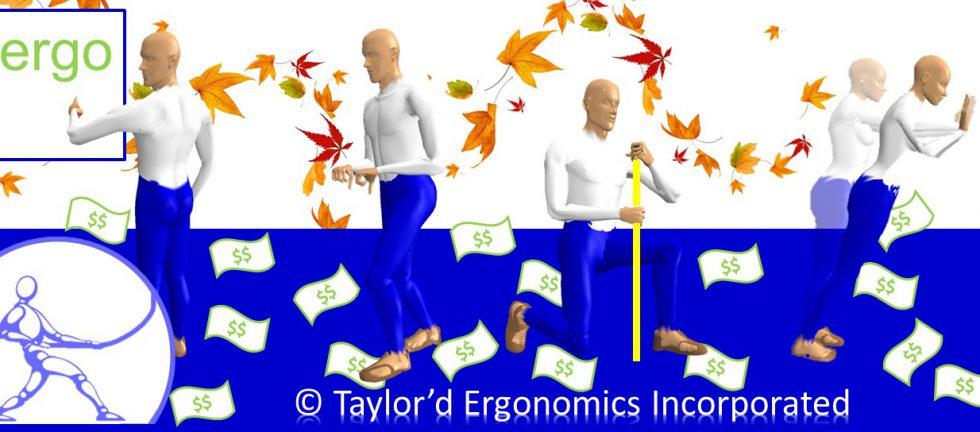Fall is budgeting time for many companies, so here’s your reminder to include ergonomics in next year’s budget.
How much to budget? Here’s a real number.
If you work at a small- to mid-size organization (100-700 employees), you should realistically budget $50,000 for ergonomics support. We’re assuming that your budget is not responsible for funding interventions (buying equipment, tools, etc.); the department with the issues can fund the intervention, and the ergonomist can help with cost-justification.
What should you get for that money?
- Weekly (or more) on-site support from a qualified ergonomist. We would schedule an ergonomist to spend 1 day/week at your facility (in Southwestern Ontario or the GTA), all year.
- Awareness materials such as monthly ergo bulletins and ergo contests at least twice per year
- Hazard-specific training for employees in offices, outdoors, driving, or manual handling.
- Technical training for engineers, safety coordinators, and return-to-work specialists
What could an ergonomist accomplish in one year, for $50,000?
- Physical and cognitive demands analyses (PCDAs) are the first step for many clients, particularly if claims management and return-to-work are priorities. Ergonomists’ services are often cost-justified based on the impact that PCDAs can have on WSIB costs. In a year, an entry-level ergonomist could complete the highest priority PCDAs for most clients of this size. We hope that your long-term vision will be to shift your focus from PCDAs to injury prevention initiatives.
- If injury prevention is the focus, consider prioritizing one of these approaches:
- Create a heat map of your organization by screening all jobs for hazards, identify the highest priorities, complete “deep dive” assessments for those jobs, research and develop recommendations, and support the implementation process
- Modify your job hazard analyses (JHA) template so that it integrates physical and cognitive demands info, and then create a database of JHAs.
- Work with employees in jobs where MSD injuries have been reported to identify and document best practices for tasks with known MSD hazards, creating a library of recommended work practices for specific tasks.
- Using specific work practices (or generic ones from our inventory) develop site-specific coaching plans that will allow supervisors or JHSC members to coach employees to use “ergonomic” work practices.
- Develop and roll out hazard-specific training for key groups of employees performing the same type of work. This could include developing videos and e-learning that demonstrates, in your workplace, how to apply ergonomics. Or it could be in-person training. You could identify “jobs” where many people are exposed to the same hazard, and create several customized programs. For example, perhaps you are seeing injuries amongst heavy equipment operators, office workers, and custodial staff. Or maybe you have injuries on specific assembly or paint lines.
- Develop a customized stretch and strength (“Move-it“) program for employees in various departments, based specifically on the type of work performed.
- Complete a specific research project to address an issue that you have identified but don’t have the in-house resources to address. You might already have a full-time ergonomist or safety coordinator on board; we can provide the resources to complete special projects that leverage their ideas and skills, without adding to their day-to-day workload. Maybe one of these project ideas will spark your interest:
- Need to short-list, trial, select and implement the best material handling device for transporting water heaters and furnaces up and down residential stairs? Or the best new patient transfer device? Or the best new utility service vehicle?
- Want to implement job rotation for an entire department, scientifically?
- Bringing in a new line but you want to avoid the historical hazards of the previous line?
- Curious about whether exoskeletons would be effective in a specific department?
If you’d like to run an idea for next year’s ergo program goals past an ergonomist, give us a call (519-623-7733) or shoot us a message (info@taylordergo.com) and we’ll meet with you. Does your company do deliverable-based budgets? We’ll help you make and execute a plan.


